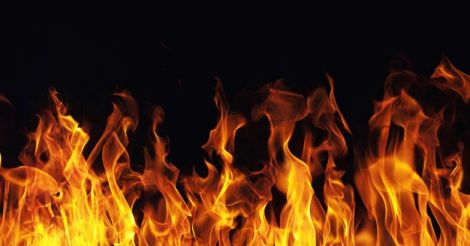Accidents and disasters do kill a large number of people every year. Disasters can be either natural as in the case of cyclones, earthquakes and floods, or man-made such as fire, chemical or nuclear spills.
What is important to note here is that when disasters strike, some people die, and many others survive. When the margin between death and survival is small and there is no time left to think, what frequently makes a difference is prior training in survival skills.
 Image: Sourced by the author
Image: Sourced by the authorThis article provides critical information that will enable us to survive a fire at home or workplace.
It describes in simple terms what we should do and should not do, and why, when faced with specific fire situations. Those interested in knowing more can check out the further reading section.
The topic of forest fire will be addressed in my next article.
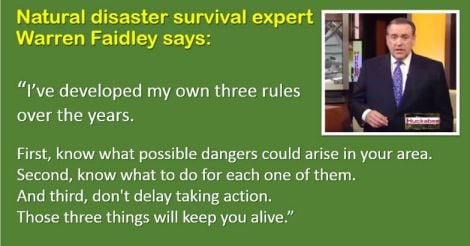 Image: Sourced by the author
Image: Sourced by the authorDomestic fire
In India, 20,000 people die every year due to fire. The vast majority of these are fires that occur at home, and unsurprisingly, 65% of the victims are women.
Home fire spreads and kills rapidly; it takes less than two minutes for a small fire that starts on the floor to hit the ceiling. This means that on average, we have less than two minutes to get out of the house.
In the US, fire kills more people every year than all other natural disasters combined. The majority of deaths occur by smoke inhalation than through burns.
Fire needs three elements: oxygen, heat source and fuel. Cutting off any one or more of these is essential to stop the fire.
 Image: Sourced by the author
Image: Sourced by the author1. The first thing to do when we encounter a domestic fire is the “fight or flight” decision. That is, whether we should fight and try to extinguish it, or escape with our life. This is a tough call; and must be made really quickly.
However, if we decide to stay back and fight, the following conditions must be met:
a) the fire was detected early and is sufficiently small
b) smoke shouldn’t be suffocating us or blocking our view
c) we are not putting others’ life at risk by delaying their escape
d) we have a clear exit plan, should things get worse.
2. At home, the commonest place where fire breaks out is in the kitchen—typically at the gas stove while cooking. Commonly, it is the oil or grease in a cooking pan that catches fire. The easiest and quickest thing to do is to place a lid over the pan, which kills the fire instantly by cutting off oxygen supply. A dinner plate can be used if the lid can’t be found.
Another method is to pour baking soda powder (sodium bicarbonate) on the fire. It works like a fire extinguisher, by generating carbon dioxide.
Pouring salt or sand is yet another technique to put out minor oil fires in the kitchen; both these agents act by creating a physical barrier between the fire and air.
The wrong thing to do—and a common mistake—is to pour water into the burning oil. Water is heavier than oil; it sinks to the bottom and does not extinguish the fire. Instead, it splashes burning oil outside, causing the fire to spread.
Ideally, a fire extinguisher must be available for immediate use at home.
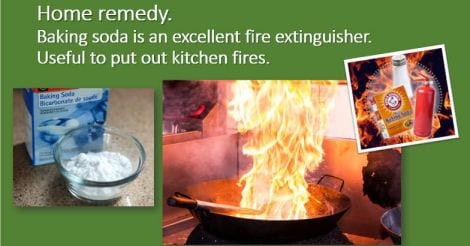 Image: Sourced by the author
Image: Sourced by the author3. Along with this, it is important to cut the fuel supply by turning off the gas. If the gas cylinder catches fire, it can be easily put out using a wet cloth (see video below). Gas cylinders can heat up after prolonged exposure to fire and sometimes explode catastrophically.
4. LPG (cooking gas) is odourless, but it is mixed with ethyl mercaptan on purpose so that we can detect a leak by the unmistakable foul smell. Being heavier than air, LPG sinks to the floor, filling up a closed kitchen from the floor upwards almost like water filling a bathtub.
If a leak is detected at home, we must gently open the doors and windows to let the gas out. Sparks must be avoided at all costs. Sparks can be accidentally generated by turning electrical switches on or off, sometimes even by a refrigerator that turns itself on and off.
If a gas leak is detected, it is important to get out of the house immediately and return only after a professional has verified that it is safe to do so.
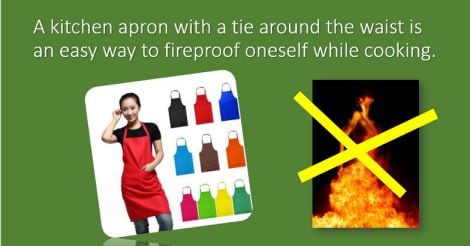 Image: Sourced by the author
Image: Sourced by the author5. If our clothes catch fire while cooking, an assistant can help by covering us immediately with a blanket, choking the fire of oxygen. It is important to avoid wearing material like nylon that can easily catch fire, while working in the kitchen.
6. Indian women wear clothes that have long loose ends, such as shawls and sarees, which can catch fire quickly even without their noticing. At home, fire can also break out from candles left unattended, as well as from lamps lit for worship.
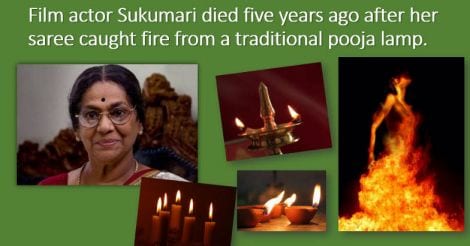 Image: Sourced by the author
Image: Sourced by the author7. If we are alone in the kitchen and our clothes catch fire, it is best to remain calm and roll on the ground once, thus starving the fire of oxygen. Frantically running outside will worsen the fire by providing a fresh supply of oxygen. Unless we know this step beforehand, almost invariably we would do the wrong thing when the situation arises.
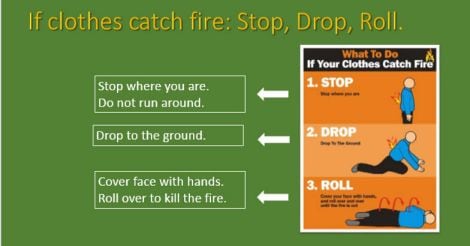 Image: Sourced by the author
Image: Sourced by the author8. Smoke kills: Many people die during indoor fires from smoke inhalation, and not due to actual burns. Technically, smoke is a mixture of fine solid particles such as soot and ash, vapours and assorted gases.
Modern-day furnishings use synthetic polymers (seen in plastics, upholstery, curtains, nylon, carpets, paint) which generate numerous toxic gases when they catch fire. Smoke from housefires contains lethal gases such as carbon monoxide, hydrogen cyanide, hydrogen chloride and phosgene.
Many modern homes and buildings are confined spaces without natural ventilation. During a fire, these closed spaces effectively turn into gas chambers, where toxic gases can easily suffocate and kill the occupants.
Carbon monoxide (CO) is a colourless, odourless gas that is generated during incomplete burning of any carbon-containing fuel such as wood, coal, oil or cooking gas. Complete combustion in the presence of ample amounts of oxygen produces carbon dioxide (CO2). As oxygen levels drop, incomplete combustion occurs, generating carbon monoxide.
When inhaled, carbon monoxide selectively binds to haemoglobin in blood, preventing the transport of oxygen to our tissues. Death occurs when our tissues suffocate without oxygen.
Carbon monoxide also causes confusion and disorientation, a situation made worse by dropping oxygen levels as the fire continues to burn.
In addition, smoke contains many chemicals including ammonia and sulphur dioxide that can irritate our eyes and damage our lungs. As a result, we might not be able to find our way out to safety if we inhale smoke for too long.
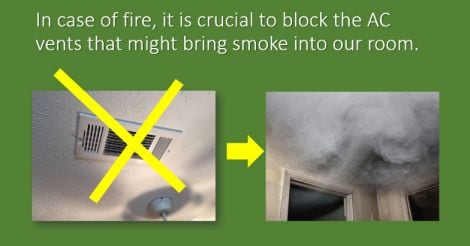 Image: Sourced by the author
Image: Sourced by the authorSeven years ago, in the AMRI hospital tragedy of Kolkata, 93 victims—mostly patients—died of smoke inhalation as they were trapped in a centrally airconditioned seven-storied building. After a fire broke out in the basement at 3 am, the smoke rapidly spread everywhere through the AC vents, suffocating the victims to death.
9. How to escape from smoke:
It is obvious that limiting exposure to smoke is as important as staying away from the fire. A rolled up wet towel can be used to block the smoke from coming in through gaps below doors. Duct tape can be used to seal smaller gaps. Windows must either be kept closed to prevent smoke getting in from outside; or opened to let the smoke out as the case might be. A soft wet cloth held over the nose and mouth might help filter out some of the smoke.
 Image: Sourced by the author
Image: Sourced by the authorSmoke rises to the upper half of the room—therefore we could suffocate easily while standing up. Hence while exiting, if there is smoke around, it is safer to crawl face down on the floor where clean air can still be found, and visibility is better.
Feeling our way through thick smoke and darkness can be quite a challenge in a panic situation. Therefore, it is helpful to practice fire drills with the family periodically to ensure we can find our way out in the dark if the need suddenly arose.
Smoke could affect our visibility even during the day. Feeling around for familiar furniture and walls can guide us to doors or windows. If a door is hot to touch, it is better not to open it, as there could be a raging fire outside, waiting to come in. In fact, doors serve as effective fire barriers while we search for another exit.
Indoor smoke contains inflammable vapours which can catch fire either from introduction of oxygen (backdraft) or due to a sudden rise in temperature (flashover).
Those living or working in high rise buildings must be well-versed with fire safety protocols of the site. Emergency exit and access areas must never be blocked with objects such as old furniture or vehicles.
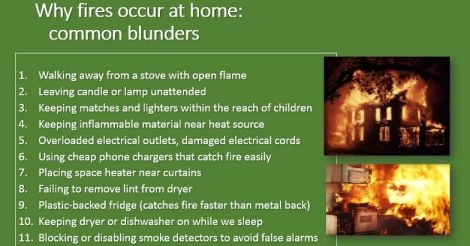 Image: Sourced by the author
Image: Sourced by the author10. Fire evacuation must be done calmly and quickly but without panic, using the stairs only. The lift (elevator) must never be used in case of fire unless it was specifically marked safe. The reason is that lifts can fail and we could get stuck inside.
As we leave the building, closing all the doors and windows behind us will help keep the fire contained and starved of oxygen supply. Some fires even die down after running out of oxygen.
Each second counts—it is important to get out safely first, and then call for help. Time must not be wasted in collecting our belongings. Going back inside the house to collect our things is foolish and dangerous because poisonous gases can kill us.
Children and older people with mobility problems must also be familiar with fire drills; they require special consideration during evacuation. Pet rescue plans must be included in the family evacuation drill.
To transfer frail or unconscious persons to safety without using any equipment, it is helpful to know the fireman’s lift, a simple but elegant technique where an adult can easily carry another adult on his shoulders.
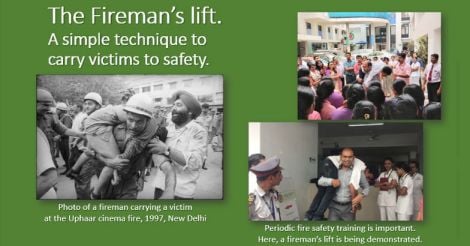 Image: Sourced by the author
Image: Sourced by the author11. If we are trapped in a room in a tall building where escape through the door is not possible, the best option is to do everything to keep smoke from entering our room, call for help and wait for fire rescue workers. The closed door will block the fire out for some time. Filling a bathtub or bucket with cold water, using it to soak a large mattress and jamming it against the door using a table or chair will buy us more time.
Waving or hanging a white sheet through the window is a universal signal that can attract the attention of fire rescue workers from outside. Window curtains must be removed to avoid catching fire and for better visibility from outside. At night, a flashlight can be used to signal for help.
For those who want to acquire every available fire safety option, personalised escape ladders and related devices are commercially available; these can be used to haul ourselves down a few floors through the window in desperate situations.
 Image: Sourced by the author
Image: Sourced by the author12. Fire extinguishers are to be used at an early stage, to put out small fires before it causes large-scale destruction. For this, we must already know how to operate the fire extinguisher closest to our place of work. Each extinguisher will have clear instructions printed on it.
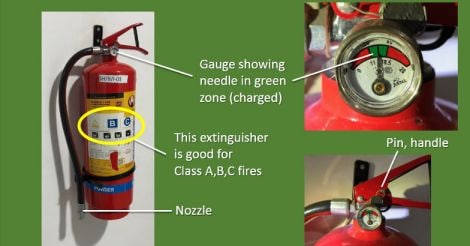 Image: Sourced by the author
Image: Sourced by the authorFor homes or small businesses, the ideal fire extinguisher to get would be A,B,C compatible so that it can be used on all types of fires. Fire extinguishers must be kept loaded or charged, and must not be empty, as is occasionally the case. There is a red-green indicator gauge near the handle. If the needle is located in green, it means that the extinguisher is ready for use (see picture above).
After pulling the pin, it must be pointed towards the base of the fire and discharged fully by squeezing the handle. The total discharge time would be less than a minute. Hence, the handle must only be squeezed when we are close enough to the fire, so that all of the chemical gets to act on the fire.
To understand fire extinguisher use, watch the training video below.
13. Electrical fires commonly occur due to short circuit. The first thing to do is to cut the power to the device by pulling the plug from the socket or turning off the main switch. This will downgrade an electrical fire into a class A fire (which is the same as burning wood or paper). Fire services must be contacted without delay.
 Short circuits are a major cause of electrical fires. It often happens when wires are worn out and touch each other, allowing electric current to suddenly flow through an abnormal path, generating heat, spark and fire. Image: Sourced by the author
Short circuits are a major cause of electrical fires. It often happens when wires are worn out and touch each other, allowing electric current to suddenly flow through an abnormal path, generating heat, spark and fire. Image: Sourced by the authorTo put out electrical fires, class C (chemical) fire extinguishers are required. Baking soda can also be used. Water should not be used, as it will lead to electrocution.
If a suitable extinguisher can’t be found and fire is continuing in spite of cutting the power, water can then be used. However, unlike the dry chemical from a class C fire extinguisher, water could damage the equipment permanently. Loss of data might occur in the case of computers.
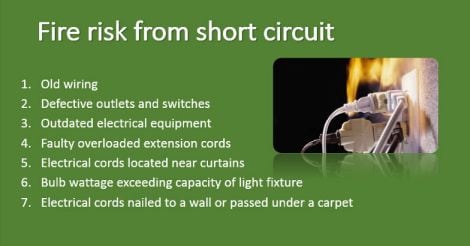 Image: Sourced by the author
Image: Sourced by the author14. While entering crowded public spaces like cinemas, circus tents, big hotels or concert halls, it is worthwhile spending a couple of extra minutes figuring out where the fire exits are located.
We must keep in mind that in case a fire broke out, there could be darkness, smoke, confusion, panic, and stampede in an unfamiliar environment. Those who are well-prepared are more likely to escape.
Such places are known for causing tragedies on a massive scale. Over the years, several fire accidents have occurred, with loss of lives ranging from hundreds to thousands. In most instances, the initial fire was tiny, easily containable, and it was a series of omissions and mistakes that led to such loss of life and property in each case.
For instance, if the staff are not trained in fire safety, the chance of putting out the fire early is lost. Fire equipment on site could be faulty. Fire safety audit recommendations are often not carried out. Emergency exits might not be marked clearly. They are sometimes kept locked, altered with illegal construction or even blocked with old furniture. Exit doors that open only inwards have caused great tragedies when panic-stricken crowds tried to push it open from inside.
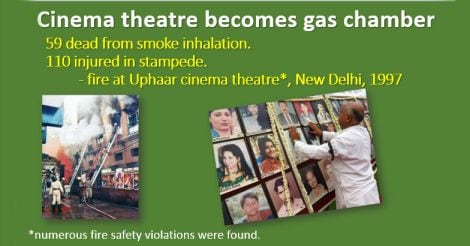 Image: Sourced by the author
Image: Sourced by the authorOvercrowding, inadequate fire exits, lack of adherence to fire safety norms during construction, apathy towards basic preventive measures, lack of periodic fire drills, defective electrical wiring and unsafe use of fire and fireworks in public places are some problems that apply to India in particular.
15. Fire prevention is better than cure
Fire is incredibly powerful and destructive; even a few seconds’ delay on our side can cost lives. However, during times of good health, there is a natural human tendency to overlook the importance of fire safety measures.
A commonly heard excuse for sloppy fire safety standards is:
“We haven’t had a fire yet, so we must be safe”. This is the wrong attitude—as fire spares no one. History is replete with innumerable examples of fire tragedies that were the direct result of human ignorance and omission. It is prudent to adhere to fire safety protocols, participate in fire drills and get periodic training by fire safety officers.
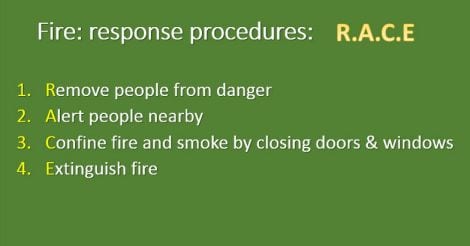 Image: Sourced by the author
Image: Sourced by the authorFurther reading
Dramatic video showing how quickly a small fire can reach up to the ceiling in less than 2 minutes
How to put out a gas cylinder on fire using a blanket
Precautions to follow if there is gas leak at home
How to use a fire extinguisher
How smoke inhalation causes death
Basement fire kills 93 people at Kolkata hospital from smoke inhalation
Common causes of electrical fires
How short circuits occur and how to prevent electrical fires
How refrigerators can catch fire
(The author is a senior consultant gastroenterologist and deputy medical director, Sunrise group of hospitals)


























